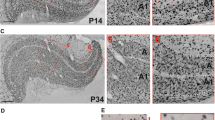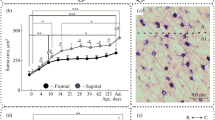Summary
The development of the glial cover of the cat's cortex cerebri examined on many stages of age after birth comprises four phases. The newborn kitten possesses a nearly epithelial cover of cortex. Each of the covering cells extends a process (TF) into the depth similar to that of a tanycyte.
-
1.
Phase of loosening (first to 15th day of life): The perikarya of the covering cells disperse in such a way that the neuropil is pushing up nearly as far as to the border of the surface. The dark cells are forming a closed layer of flat superficial processes (OF).
-
2.
Phase of transformation (16th to 30th day of life): Cells having a light contrast degenerate. They originally covered about 50% of the surface. The dark cells develop the round or oval processes (RF) with closely packed filaments of glia and the astrocytic lamellae (LF) without filaments. The terminal bars are built up at the end of this phase between all OF.
-
3.
Phase of proliferation (31st to 45th day of life): Very many LF and RF are developed. The glia cells which originally have had a big cytoplasm with a large Golgi complex are transformed into astrocytes of the cover with a small border of cytoplasm.
-
4.
Phase of maturation (46th to 60th day of life): The areas of cell attachment (specific junctions and desmosomes) are formed in large quantities between all kinds of processes.
The myelinisation in layer I is beginning after the phase of maturation.
The special development of the LF is determined. They are formed from concentric whirled piles of membranes (MW). The MW arise in the perikaryon and are gathering material in granules which are membrane bounded during the phase of loosening. The MW are shifted into bubblelike bulges of the perikaryon during the phase of transformation and afterwards form very complicated figures. At the same time very many planes of membranes must be developed in the MW while the granules disappear. Then the ramified MW deliver a great amount of LF. The intracellular membranes must be transformed into the plasmalemma during this delivery and the intracellular cisternae are opened towards the extracellular space. The significance of this process is discussed.
Zusammenfassung
An zahlreichen Altersstufen wird die Entwicklung der Gliadeckschicht des Cortex cerebri der Katze untersucht. Das neugeborene Kätzchen hat eine fast epitheliale Decklage, deren Zellen tanycytenartige Fortsätze (TF) in die Tiefe senden. Seine weitere Entwicklung läßt sich in 4 Phasen gliedern.
-
1.
Auflockerungsphase (1.–15. Lebenstag): Die Perikarya der Deckzellen treten auseinander, so daß das Neuropil bis nahe an die Oberfläche vordringen kann. Aus den dunklen Zellen wird eine durchgehende oberflächliche Fortsatzlage (OF) gebildet.
-
2.
Umbauphase (16.–30. Lebenstag): In ihr degenerieren die hellen Zellen, die ursprünglich etwa 50% der Oberfläche abdeckten. Aus den dunklen Zellen werden die ersten runden Fortsätze (RF) mit dichten Gliafilamenten und Glialamellen (LF) ohne Filamente gebildet. Am Ende der Phase sind zwischen allen OF Schlußleisten vorhanden.
-
3.
Proliferationsphase (31.–45. Lebenstag): In dieser Zeit werden LF und RF in großen Mengen gebildet. Die ursprünglich cytoplasmareichen Gliazellen, die einen großen Golgiapparat besitzen, verwandeln sich in die cytoplasmaarmen Astrocyten der Deckschicht.
-
4.
Reifephase (46.–60. Lebenstag): Zwischen allen Fortsatzarten wird eine große Zahl von Zellkontakten (specific junctions und Desmosomen) ausgebildet. Am Ende der Reifephase beginnt in Schicht I die Entwicklung der markhaltigen Nervenfasern.
Die Bildung der LF, die aus den Membranwirbeln (MW) entstehen, wurde genauer untersucht. Die MW entwickeln sich im Perikaryon und sammeln anschließend in der Auflockerungsphase Material in Form von membranbegrenzten Granula. Während der Umbauphase werden sie in blasenartige Vorstülpungen des Perikaryon geschoben und bilden dort komplizierte Formen. Dabei müssen große Membranflächen enstehen, während zugleich die Granula verschwinden. Aus den verzweigten MW werden in der Proliferationsphase große Mengen von LF abgeschoben. Bei diesem Prozeß müssen intracelluläre Membranen in Plasmalemm verwandelt werden und intracelluläre Cisternen Anschluß an den extracellulären Raum gewinnen. Die Bedeutung dieses Vorganges wird diskutiert.
Similar content being viewed by others
Literatur
Andres, K. H.: Über die Feinstruktur der Hüllen des Nervensystems der Katze (Felis catus L.). Anat. Anz., Erg.-H. 120, 483–487 (1967).
Böhme, G.: Die marginale Glia des Cortex cerebri der Ratte. Z. Zellforsch. 70, 269–278 (1966).
Bondareff, W., Myers, R. E., Brann, A. W.: Brain extracellular space in monkey fetuses subjected to prolonged partial asphyxia. Exp. Neurol. 28, 167–178 (1970).
—, Pysh, J. J.: Distribution of the extracellular space during postnatal maturation of rat cerebral cortex. Anat. Rec. 160, 773–780 (1968).
Buck, R. C., Tisdale, J. M.: An electron microscopic study of the development of the cleavage furrow in mammalian cells. J. Cell Biol. 13, 117–125 (1962).
Caley, D. W., Maxwell, D. S.: Development of the blood vessels and extracellular spaces during postnatal maturation of rat cerebral cortex. J. comp. Neurol. 138, 31–48 (1970).
Fleischhauer, K.: Über die postnatale Entwicklung der subependymalen und marginalen Gliafaserschichten im Gehirn der Katze. Z. Zellforsch. 75, 96–108 (1966).
—: Postnatale Entwicklung der Neuroglia. Acta neuropath. (Berl.), Suppl. IV, 20–32 (1968).
Hager, H., Blinzinger, K.: Über eigenartige Astrozytenfortsätze und intrazytoplasmatische Vesikelreihen (Elektronenmikroskopische Untersuchungen an Gliosen des Säugetiergehirns). Z. Zellforsch. 65, 57–73 (1965).
Haug, H.: Die Membrana limitans gliae superficialis der Sehrinde der Katze. Z. Zellforsch. 115, 79–87 (1971).
—: Die Entwicklung des Neuropil in der Sehrinde der Katze. Anat. Anz. Erg.-H. 128, 153 (1971).
Janzen, R. W. Chr.: Topographische Besonderheiten im Bau der Glia marginalis des Menschen. Z. Zellforsch. 80, 570–584 (1967).
Kessel, R. G.: Annulate lamellae. J. Ultrastruct. Res., Suppl. 10, (1968).
Meller, K., Breipohl, W., Glees, P.: The cytology of the developing molecular layer of mouse motor cortex. Z. Zellforsch. 86, 171–183 (1968).
Oksche, A.: Die pränatale und vergleichende Entwicklungsgeschichte der Neuroglia. Acta neuropath. (Berl.), Suppl. IV, 4–19 (1968).
Paul, E.: Über die Typen der Ependymzellen und ihre regionale Verteilung bei Rana temporaria L. Mit Bemerkungen über die Tanycytenglia. Z. Zellforsch. 80, 461–487 (1967).
Pehlemann, F.-W.: Die amitotische Zellteilung. Eine elektronenmikroskopische Untersuchung an Interrenalzellen von Rana temporaria L. Z. Zellforsch. 84, 516–548 (1968).
Ramsey, H. J.: Fine structure of the surface of the cerebral cortex of human brain. J. Cell Biol. 26, 323–333 (1965).
Robertson, D. M., Vogel, F. S.: Concentric lamination of glial processes in oligodendrogliomas. J. Cell Biol. 15, 313–334 (1962).
Schulz, H.: Thrombocyten und Thrombose im elektronenmikroskopischen Bild. Electron microscopy of blood platelets and thrombosis. Berlin-Heidelberg-New York: Springer 1968.
Stensaas, L. J.: The development of hippocampal and dorsolateral pallial regions of the cerebral hemisphere in fetal rabbits. I. Fifteen millimeter stage, spongioblast morphology. J. comp. Neurol. 129, 59–70 (1967).
—, Stensaas, S. S.: An electron microscope study of cells in the matrix and intermediate laminae of the cerebral hemisphere of the 45 mm rabbit embryo. Z. Zellforsch. 91, 341–365 (1968).
Sumi, S. M.: The extracellular space in the developing rat brain: Its variation with changes in osmolarity of the fixative, method of fixation and maturation. J. Ultrastruct. Res. 29, 398–425 (1969).
Tormey, J. McD.: Fine structure of the cilliary epithelium of the rabbit, with particular reference to “infolded membranes”, “vesicles”, and the effects of diamox. J. Cell Biol. 17, 641–659 (1963).
Author information
Authors and Affiliations
Additional information
Mit dankenswerter Unterstützung durch die Deutsche Forschungsgemeinschaft. Für die technische Hilfe danke ich Frau H. Prien und Frau A. Rast.
Rights and permissions
About this article
Cite this article
Haug, H. Die postnatale Entwicklung der Gliadeckschicht der Sehrinde der Katze. Z. Zellforschung 123, 544–565 (1972). https://doi.org/10.1007/BF00335548
Received:
Issue Date:
DOI: https://doi.org/10.1007/BF00335548




